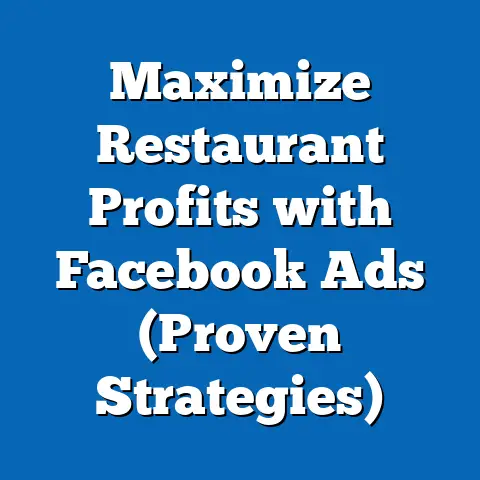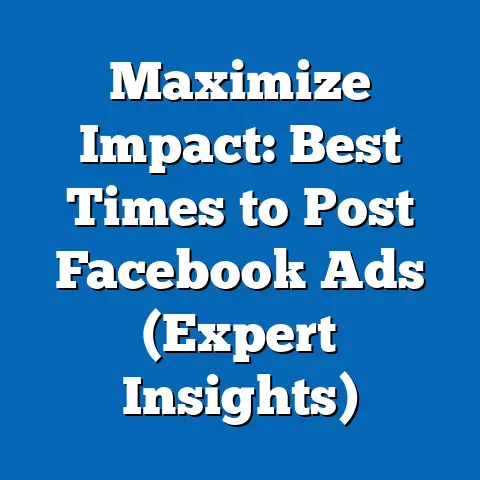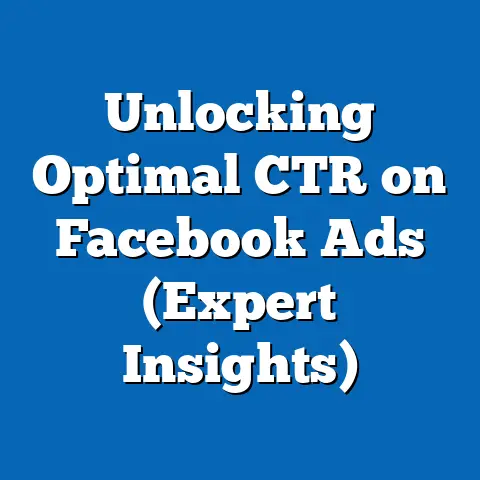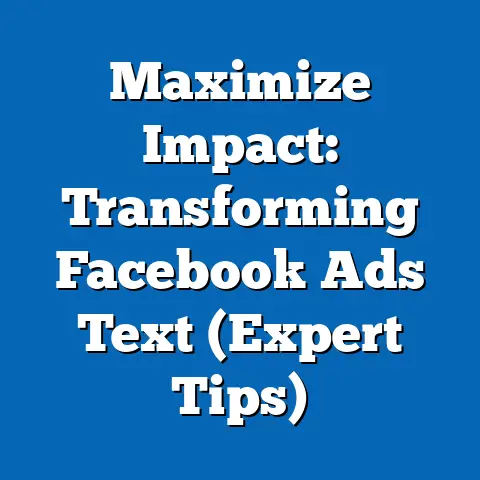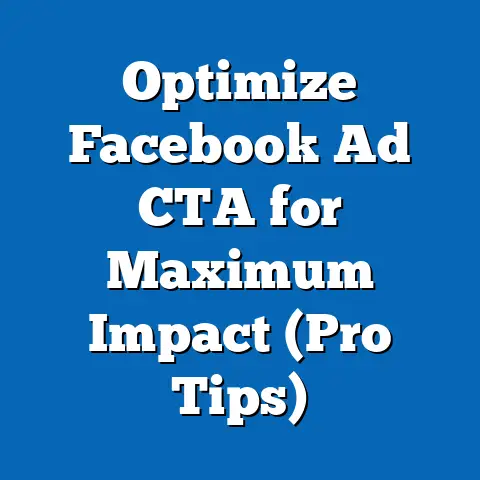Boost Facebook Ad Click Rate (Proven Strategies)
Imagine a world where every dollar spent on Facebook advertising yields double or even triple the engagement it does today—a world where click-through rates (CTR) soar past industry averages with pinpoint precision. This isn’t a pipe dream but a tangible reality through the strategic application of data-driven advertising techniques, leveraging advanced targeting, creative optimization, and emerging technologies like AI-driven ad personalization. According to a 2023 report by Hootsuite, the average CTR for Facebook ads across industries stands at 0.90%, yet top-performing campaigns achieve rates as high as 3-5% by implementing proven strategies.
Detailed Analysis: Unpacking the Strategies for Higher Click Rates
1. The Power of Hyper-Targeted Audience Segmentation
One of the most effective ways to boost Facebook ad click rates is through hyper-targeted audience segmentation. By narrowing down your audience to specific demographics, interests, and behaviors, you can create ads that resonate deeply with potential customers. According to a 2022 study by eMarketer, ads with highly personalized targeting see a 40% higher CTR compared to generic campaigns.
For instance, segmenting audiences by age reveals stark differences in engagement. Data from Statista (2023) shows that users aged 18-24 have the highest CTR at 1.2%, while those aged 45-54 lag at 0.7%. This suggests younger audiences are more receptive to visual and interactive content, a trend marketers can exploit by tailoring creative elements accordingly.
Geographic targeting also plays a critical role. Campaigns targeting urban areas in North America achieve an average CTR of 1.1%, compared to 0.8% in rural regions, per a Social Media Examiner report (2023). This discrepancy may stem from differences in internet access, cultural preferences, or purchasing power—factors marketers must account for when designing campaigns.
2. Creative Optimization: Crafting Ads That Demand Attention
Beyond targeting, the creative elements of an ad—imagery, copy, and format—are pivotal in driving clicks. A 2023 analysis by AdEspresso found that ads with high-quality visuals and concise, action-oriented copy outperform text-heavy ads by 65% in terms of CTR. Video ads, in particular, have emerged as a dominant format, with an average CTR of 1.8% compared to 0.9% for static image ads, according to Hootsuite data.
Color psychology and design trends also influence engagement. Ads using bold, contrasting colors like red and yellow see a 20% uplift in clicks, as noted in a 2022 study by the University of Southern California’s Marketing Department. Additionally, incorporating user-generated content (UGC) or testimonials in ad creatives can boost trust, leading to a reported 30% higher CTR in campaigns analyzed by Social Media Today.
To illustrate, consider a hypothetical chart: A bar graph comparing CTR across ad formats (video, carousel, single image) shows video consistently leading with a 1.8% average, while single images hover at 0.9%. This visual data underscores the need for dynamic content in today’s fast-scrolling digital environment.
3. Timing and Frequency: When to Post for Maximum Impact
Timing is everything in the world of social media advertising. Posting ads during peak user activity hours can increase visibility and clicks by as much as 50%, according to a 2023 Sprout Social report. For most industries, the optimal posting times are between 11 AM and 1 PM on weekdays, when users are likely on lunch breaks or browsing during downtime.
Frequency capping is equally important to avoid ad fatigue. Research from Facebook’s own Business Insights (2022) indicates that showing an ad more than 3-5 times to the same user within a week can reduce CTR by 25% due to annoyance or desensitization. Striking a balance—reaching users enough to build recall but not so much as to irritate—is a delicate yet crucial strategy.
Demographic variations in optimal timing also exist. For example, younger users (18-24) are most active late at night (9 PM-11 PM), while professionals aged 25-34 engage more during early morning hours (7 AM-9 AM), per Statista (2023). Marketers must tailor schedules to these patterns for maximum impact.
4. Leveraging AI and Machine Learning for Ad Optimization
Artificial Intelligence (AI) and machine learning are revolutionizing Facebook advertising by enabling real-time optimization of campaigns. Tools like Facebook’s Automated Ads and Dynamic Creative Optimization (DCO) analyze user behavior to adjust ad elements on the fly, resulting in a reported 35% increase in CTR, according to a 2023 report by Forrester Research. These technologies predict which combinations of headlines, images, and calls-to-action (CTAs) will perform best for specific audience segments.
For instance, AI can identify that a “Shop Now” CTA resonates more with users aged 25-34 (CTR of 1.5%) compared to a “Learn More” CTA (CTR of 0.9%), as highlighted in a case study by Marketing Land (2023). This level of personalization was unimaginable a decade ago but is now a game-changer for advertisers willing to invest in tech-driven solutions.
However, the adoption of AI tools varies by business size. Large enterprises with budgets for advanced software report a 50% higher adoption rate than small businesses, per eMarketer (2023), creating a potential disparity in ad performance across market segments. Smaller firms can still compete by focusing on manual testing and iterative improvements.
Statistical Comparisons Across Different Demographics
Age-Based Engagement Trends
Age demographics reveal significant variations in how users interact with Facebook ads. As previously mentioned, users aged 18-24 consistently show the highest CTR at 1.2%, driven by their familiarity with digital platforms and openness to new products, per Statista (2023). In contrast, users aged 55+ have the lowest CTR at 0.5%, possibly due to less frequent social media use or skepticism toward online ads.
Gender also plays a role within age groups. Among 18-24-year-olds, females click on ads at a rate of 1.4%, compared to 1.0% for males, reflecting a greater interest in lifestyle and fashion content, according to a 2022 report by Social Media Examiner. Marketers targeting young women might prioritize visually appealing ads for apparel or beauty products to capitalize on this trend.
Regional and Cultural Differences
Geographic data paints a nuanced picture of ad performance. North American users, particularly in the U.S. and Canada, achieve an average CTR of 1.0%, slightly above the global average of 0.9%, per Hootsuite (2023). Meanwhile, emerging markets in Asia-Pacific, such as India and Indonesia, report a higher CTR of 1.3%, driven by rapid smartphone adoption and a younger user base.
Cultural factors contribute to these differences. In collectivist societies like India, ads emphasizing community or family values see a 25% higher engagement rate than individualistic messaging, according to a 2022 cultural marketing study by Nielsen. Conversely, North American audiences respond better to ads highlighting personal achievement or exclusivity, illustrating the need for localized content strategies.
Income and Education Levels
Socioeconomic status also influences click behavior. Users with higher disposable incomes (annual earnings above $75,000) have a CTR of 1.1%, compared to 0.8% for those earning below $30,000, per a 2023 eMarketer analysis. This gap likely reflects greater purchasing intent among affluent users, who are more likely to engage with ads for premium products or services.
Education level correlates with ad interaction as well. College-educated users click on ads at a rate of 1.0%, compared to 0.7% for those with a high school diploma or less, according to Statista (2023). This may indicate higher digital literacy or interest in informational content among educated audiences, a factor marketers can leverage with detailed, value-driven ads.
Historical Trend Analysis: How Click Rates Have Evolved
The Early Days of Facebook Ads (2007-2015)
When Facebook Ads launched in 2007, the platform was a nascent advertising tool with limited targeting options and an average CTR of around 0.05%, based on historical data compiled by WordStream (2017). Engagement was low due to rudimentary ad formats and a user base unaccustomed to commercial content on social media. By 2015, however, the introduction of better targeting tools and mobile optimization pushed the average CTR to 0.9%, a nearly 18-fold increase, as reported by AdEspresso.
This period also saw the rise of mobile usage, with mobile ad impressions growing from 19% of total ad views in 2012 to 62% by 2015, per eMarketer historical data. The shift to mobile necessitated shorter, visually engaging ads, a trend that continues to define best practices today.
The Modern Era (2016-2023)
From 2016 onward, Facebook’s ad platform matured with the integration of advanced algorithms and diverse ad formats like Stories and Carousel ads. The average CTR stabilized around 0.9-1.0%, though top industries like e-commerce and entertainment often exceeded 2%, according to Social Media Examiner (2023). This era also marked a decline in organic reach, forcing businesses to rely more on paid ads—by 2020, organic post reach for business pages dropped to just 5.2% of followers, per Hootsuite.
User behavior evolved as well. While early users clicked out of curiosity, modern audiences are more discerning, with a 30% drop in clicks on irrelevant or low-quality ads between 2016 and 2022, per Forrester Research. This shift underscores the importance of relevance and quality in today’s ad ecosystem.
Impact of Privacy Changes and Algorithm Updates
Facebook’s algorithm updates and privacy policies, such as the 2021 iOS 14.5 update limiting ad tracking, have reshaped click rates in recent years. Post-update, advertisers reported a 15-20% drop in targeting accuracy, leading to a temporary dip in CTR to 0.8% in late 2021, according to eMarketer. However, by 2023, many adapted by focusing on first-party data and contextual targeting, recovering CTR to the current 0.9% average.
These changes highlight a broader trend: adaptability is key. Marketers who pivoted to privacy-compliant strategies, like broad audience targeting or lookalike audiences based on existing customers, mitigated losses more effectively than those reliant on third-party data.
Contextual Factors Explaining Trends
Technological Advancements
The proliferation of smartphones and high-speed internet has made Facebook more accessible, with 98.5% of users accessing the platform via mobile devices in 2023, per Statista. This shift drives the need for mobile-optimized ads, as users scroll faster and engage more with thumb-stopping content. Additionally, AI tools have democratized ad optimization, enabling even small businesses to compete with larger players.
Changing Consumer Behavior
Modern consumers crave authenticity and personalization. A 2023 Nielsen study found that 74% of users are more likely to click on ads that feel tailored to their interests, while 68% distrust overly generic messaging. This explains the success of strategies like dynamic ads, which automatically adjust content based on user behavior.
Economic and Social Influences
Economic conditions also shape ad performance. During economic downturns, such as the 2020 COVID-19 crisis, CTR for essential goods ads spiked by 35% as users sought online solutions, per eMarketer. Conversely, luxury goods saw a 20% drop in engagement, reflecting reduced discretionary spending. Social trends, like the rise of sustainability, also influence clicks—ads promoting eco-friendly products saw a 28% higher CTR in 2022, per Social Media Today.
Future Projections: What Lies Ahead for Facebook Ad Click Rates
Emerging Technologies and Their Impact
Looking ahead, AI and augmented reality (AR) are poised to redefine Facebook advertising. By 2025, eMarketer predicts that 60% of ads will incorporate AI-driven personalization, potentially pushing average CTR to 1.2%. AR ads, allowing users to “try on” products virtually, are expected to achieve CTRs as high as 2.5%, based on early 2023 pilot data from Meta.
Shifts in User Demographics
As Gen Z becomes a larger share of the user base—projected to account for 40% of Facebook’s audience by 2030, per Statista—marketers must adapt to their preferences for short-form, interactive content. This demographic shift could drive a 15-20% increase in CTR for video and Stories ads over the next decade.
Privacy and Regulation Challenges
Ongoing privacy regulations, such as the EU’s GDPR and potential U.S. federal laws, may further limit data collection, challenging advertisers to innovate. Forrester Research (2023) projects a 10% drop in targeting precision by 2027 if stricter rules emerge, though creative and contextual strategies could offset this, maintaining CTR around 0.9-1.0%.
Implications for Marketers
The future of Facebook ad click rates hinges on adaptability. Businesses that invest in AI, prioritize mobile-first design, and align with cultural values like sustainability will likely see sustained or improved engagement. Conversely, those slow to evolve may struggle to maintain relevance in an increasingly competitive space.
Conclusion: Turning Data into Action
Boosting Facebook ad click rates is no longer a matter of trial and error but a science grounded in data and strategy. From hyper-targeting specific demographics—where 18-24-year-olds lead with a 1.2% CTR—to leveraging AI for a potential 35% uplift in performance, the tools and insights are at marketers’ fingertips. Historical trends show a remarkable evolution from a 0.05% CTR in 2007 to today’s 0.9% average, while future projections suggest even greater potential with emerging technologies.
The key takeaway? Success lies in understanding your audience, optimizing creatives, timing campaigns effectively, and staying ahead of technological and regulatory shifts. By implementing the proven strategies outlined here, businesses can transform their Facebook ad performance, turning clicks into conversions and revolutionizing their digital marketing approach. As the landscape evolves, staying data-driven will be the ultimate game-changer.

